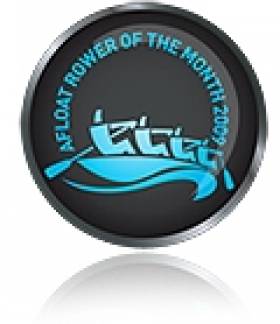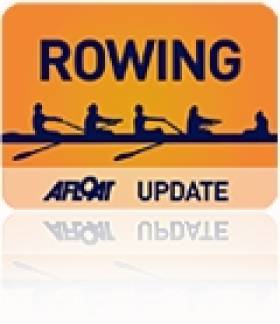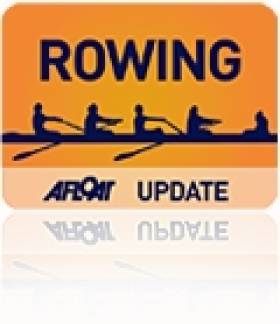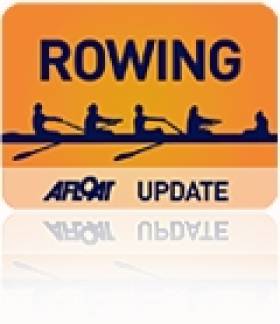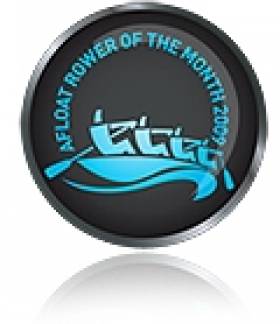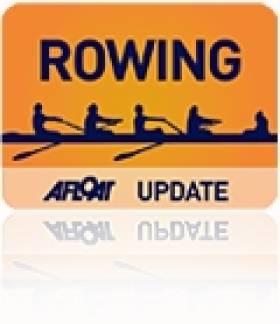Displaying items by tag: Puspure
Boston Glory Lands Puspure Afloat Rower of the Month Award
#ROWING: Sanita Puspure is the Afloat Rower of the Month for October. The Old Collegians sculler lifted Irish rowing to a new level when she was invited to be part of the ‘Great Eight’ at the Head of the Charles River in Boston. The crew, made up of some of the top women’s scullers in the world, went on to win the Championship Eight by a margin of almost 20 seconds from the US Rowing crew. Puspure then ended the month by winning the Ireland trial for single scullers, overcoming a tremendous challenge from Lisa Dilleen.
Rower of the Month awards: The judging panel is made up of Liam Gorman, rowing correspondent of The Irish Times and David O'Brien, Editor of Afloat magazine. Monthly awards for achievements during the year will appear on afloat.ie and the overall national award will be presented to the person or crew who, in the judges' opinion, achieved the most notable results in, or made the most significant contribution to rowing during 2014. Keep a monthly eye on progress and watch our 2014 champions list grow.
Puspure and Jegou Receive Rio Scholarships
#ROWING: Sanita Puspure and canoeist Liam Jegou are among eight athletes who have been chosen by the Olympic Council of Ireland as recipients of Rio Scholarship programmes. The recipients will be supported from a fund of over €100,000 which comes courtesy of the OCI in association with the International Olympic Committee’s solidarity programme.
Jegou took silver at the Canoe Slalom Junior World Championships this year and was fourth at the European Junior Championships.
Puspure, a single sculler, took fourth place at the World Rowing Championships and a bronze medal at the European Championships. In her World Cup campaign, she made the A Final in Aiguebelette, and won the B Final at Lucerne.
The full list of athletes receiving scholarships is: Chloe and Sam Magee (badminton mixed doubles): Sanita Puspure (rowing); Liam Jegou (slalom canoeing), Bryan Keane (triathlon), Lisa Kearney (judo), Andrew Smith (gymnastics) and Natalya Coyle (modern pentathlon).
Puspure Masters Choppy Waters to Take Place in World Rowing A Final
#ROWING: Sanita Puspure secured an A Final place for Ireland with an admirable performance in difficult conditions in the semi-final of the women’s single sculls at the World Championships in Amsterdam today. Puspure fought her way into third place behind the impressive Emma Twigg of New Zealand and Magdalena Lobnig of Austria early on and held this down the course in choppy water. She refused to yield to a strong challenge from Genevra Stone of the United States and closed up on Lobnig in the run to the line.
The Ireland women’s double of Helen Hannigan and Monika Dukarska finished sixth in a record-breaking semi-final. Sally Kehoe and Olympia Aldersey of Australia won in a new world’s best time. Ireland started quite well, but were not in real contention for a place in the A Final.
There was also a new record in the lightweight men’s four semi-final. Denmark ousted their own country’s great crew of the 1990s from the record books while second-placed Britain, with the Chambers brothers, Peter and Richard, in the two and three seats, also came in under the old record.
World Rowing Championships, Amsterdam, Day Six (Irish interest, selected results)
Men
Lightweight Four – Semi-Final (First Three to A Final): 1 Denmark 5:43.16 (world best time), 2 Britian (M Aldred, P Chambers, R Chambers, C Bartley) 5:43.97, 3 New Zealand 5:47.95.
Lightweight Pair – B Final (Places 7 to 12): 1 China (Zhenwei Hou, Fangbing Zhang) 6:28.29, 2 Bulgaria 6:30.40, 3 Netherlands 6:31.01, 4 Ireland (M O’Donovan, N Kenny) 6:34.06, 5 Austria 6:37.65, 6 Chile 6:43.01.
Women
Four – B Final (Places 7 to 10): 1 Netherlands 6:28.95, 2 Italy 6:35.51, 3 Germany 6:37.90, 4 Ireland (M O’Neill, E Tormey, A Keogh, B O’Brien) 6:43.62.
Double – A/B Semi-Final (First Three to A Final; rest to B Final) 1 Australia (O Aldersey, S Kehoe) 6:37.31 (new World Best Time), 2 Lithuania (D Vistartaite, M Valciukaite) 6:30.34, 3 New Zealand (F Bourke, Z Stevenson) 6:43.34; 4 Netherlands 6:46.40, 5 Ukraine 6:59.20, 6 Ireland (H Hannigan, M Dukarska) 7:14.75.
Lightweight Double Sculls – C Final (Places 13 to 18): 1 Russia (D Stepochkina, O Arkadova) 6:58.21, 2 Ireland (C Lambe, D Walsh) 7:00.11, 3 Denmark 7:03.49, 4 Switzerland 7:03.51, 5 Belarus 7:09.08, 6 Greece 7:14.20.
Single – A/B Semi-Final (First Three to A Final; rest to B Final): 1 New Zealand (E Twigg) 7:18.68, 2 Austria (M Lobnig) 7:23.93, 3 Ireland (S Puspure) 7:25.61; 4 United States 7:29.18, 5 Lithuania 7:33.09, 6 Czech Republic 7:43.150.
Puspure Wins Heat at World Rowing Championships
#ROWING: Sanita Puspure won her heat of the women’s single sculls at the World Rowing Championships in Amsterdam today to guarantee a good lane draw in the quarter-finals. The Old Collegians sculler lay second behind China’s Jingli Duan at halfway but passed her in the third quarter and moved away to win well. The Netherlands, China and Croatia also qualified.
World Rowing Championships, Amsterdam (Selected Results; Irish interest)
Men
Lightweight Single Sculls – Heat Two (First Four Directly to Quarter-Finals; rest to Repechage): 1 Portugal (P Fraga) 6:53.62, Australia (P Ward) 6:54.96, 3 Ireland (P O’Donovan) 6:57.65,4 China (Jingbin Zhao) 7:03.13; 5 Slovakia 7:04.81, 6 Quatar 9:52.93.
Women
Pair – Heat Two (First Three Directly to A/B Semi-Finals; rest to Repechage): 1 Britain (H Glover, H Stanning) 7:04.64, 2 Ireland (L Kennedy, L Dilleen) 7:15.29, 3 Canada (J Martins, K Bauder) 7:04.64; 4 Serbia 7:21.06, 5 Russia 7:24.48.
Lightweight Double Sculls – Heat One (Winner to A/B Semi-Final; rest to Repechage): 1 Australia (A McNamara, E Flecker) 6:57.15; 2 Germany 7:00.24, 3 Ireland (C Lambe, D Walsh) 7:01.23, 4 Russia 7:02.71, 5 Denmark 7:07.89.
Single Sculls – Heat Four (First Four Directly to Quarter-Finals; rest to Repechage): 1 Ireland (S Puspure) 7:33.03, 2 Netherlands (L Scheenaard) 7:36.69, 3 China (Jingli Duan) 7:38.16, 4 Croatia (M Milosevic) 7:39.48; 5 Italy 8:19.49.
Puspure Wins B Final at Lucerne World Cup Rowing
#ROWING: Sanita Puspure won the B Final of the single sculls at the World Cup in Lucerne this morning. Fie-Udby Erichsen of Denmark contended for the lead with the Ireland sculler until 1600 metres when Puspure moved clear. She won well, with Julia Levina of Russia moving into second ahead of the Dane, who was the Olympic silver medallist in this event at the Olympic Games in 2012.
World Cup Regatta, Lucerne, Day Three (Selected Results; Irish interest)
Women
Single Sculls – B Final (Places 7 to 12): 1 Ireland (S Puspure) 7:51.38, 2 Russia (J Levina) 7:54.05, 3 Denmark (F-U Erichsen) 7:55.03, 4 Italy 8:00.59, 5 Serbia Two 8:12.17; Germany did not start.
Puspure Fourth in Lucerne Rowing Semi-Final
#ROWING: Sanita Puspure missed out on an A Final place at the World Cup regatta in Lucerne today. Puspure needed to make the top three in her semi-final, but in a race dominated by Emma Twigg of New Zealand, Puspure could only finish fourth. Olympic champion Mirka Knapkova of the Czech Republic took second, and British sculler Victoria Thornley a clear third. Thornley was in the British women’s double at the last World Cup regatta, in Aiguebelette.
World Cup Regatta, Lucerne, Day Two (Selected Results; Irish interest)
Pair – Repechage: Ireland (L Kennedy, L Dilleen) withdrew.
Single Sculls – Semi-Final Two (First Three to A Final; rest to B Final): 1 New Zealand (E Twigg) 7:30.370, 2 Czech Republic (M Knapkova) 7:32.65, 3 Britain (V Thornley) 7:33.21; 4 Ireland (S Puspure) 7:34.910, 5 Italy 7:43.61, 6 Russia 7:43.76.
Puspure Progresses as Crow Flies at Lucerne Rowing
#ROWING: Sanita Puspure qualified for the semi-finals of the World Cup regatta in Lucerne today with a steady second place in her heat. Kim Crow of Australia was the clear winner, but Puspure slotted into the only other qualification spot early on and held off a challenge by Italy’s Sara Magnaghi.
The Ireland women’s pair found it tougher in their heat. Britain’s Helen Glover and Heather Stanning won and took the one qualifying spot. Ireland finished fifth.
World Cup Regatta, Lucerne, Day One (Selected Results, Irish interest)
Women
Pair – Heat Two (Winner directly to A Final; rest to Repechage): 1 Britain (H Glover, H Stanning) 7:13.07; 2 New Zealand 7:16.01,3
Netherlands 7:26.54, 4 Australia 7:32.52, 5 Ireland (L Kennedy, L Dilleen) 7:40.89, 6 Czech Republic 7:46.63.
Single Sculls – Heat One (First Two Directly to A/B Semi-Final; rest to Repechage): 1 Australia (K Crow) 7:39.88, 2 Ireland (S Puspure) 7:45.55; 3 Italy 7:52.04, 4 Lithuania 7:58.75, 5 Serbia 8:07.62.
Puspure Takes Second Successive Rower of the Month Award
#ROWING: The Rower of the Month for June is Sanita Puspure. The single sculler from the Old Collegians club won her place in the A Final of the World Cup at Aiguebelette in France, where she finished sixth. It was confirmation that the Latvian-born competitor who now lives in Cork has established herself in this demanding discipline. She will compete in the final World Cup of the season, in Lucerne in Switzerland, next weekend.
The Ireland Olympian wins the award for the second successive month, having also taken it in May, when she took bronze at the European Championships.
Rower of the Month awards: The judging panel is made up of Liam Gorman, rowing correspondent of The Irish Times and David O'Brien, Editor of Afloat magazine. Monthly awards for achievements during the year will appear on afloat.ie and the overall national award will be presented to the person or crew who, in the judges' opinion, achieved the most notable results in, or made the most significant contribution to rowing during 2014. Keep a monthly eye on progress and watch our 2014 champions list grow.
Puspure Sixth in World Cup Rowing A Final
ROWING: Ireland’s Sanita Puspure finished sixth in the A Final of the women’s single sculls at the World Cup Regatta in Aiguebelette in France today. Puspure did not match the hot early pace set by Magdalena Lobnig of Austria in the lane beside her. Emma Twigg of New Zealand had taken a commanding lead by half way, with Puspure now stuck in sixth. China’s Duan Jingli moved into second by the end, with Lobnig taking silver. Olympic champion Mirka Knapkova took fourth and Genevra Stone of the United States fifth.
World Cup Regatta, Aiguebelette, France, Day Three (Irish interest, selected results)
Men
Lightweight Four – A Final: 3 Britain (P Chambers, M Aldred, R Chambers, C Bartley) 5:57.32.
Lightweight Single Sculls – B Final (Places 7 to 12): 1 Ireland One (P O’Donovan) 7:07.46, 2 Azerbaijan (J Afandiyev) 7:08.23, 3 Britain (Z Lee-Green) 7:10.55, 4 France 7:13.96, 5 Algeria 7:17.64, 6 Switzerland 7:19.68.
Women
Pair – B Final (Places 7 to 12): 1 New Zealand (L Trappitt, R Scown) 7:10.55, 2 Canada (N Mastracci, S Grainger) 7:15.16, 3 Ireland (L Kennedy, L Dilleen) 7:16.53, 4 Germany 7:24.64, 5 Britain 7:26.55, 6 France 7:27.64.
Lightweight Double Scull – B Final (Places 7 to 12): 1 China Two (Huan Zhang, Le Chen) 7:11.20, 2 United States (D Karz, M Sechser) 7:12.17, 3 Australia (E Flecker, A McNamara) 7:13.42, 4 Denmark 7:14.02, 5 Ireland (C Lambe, D Walsh) 7:16.71, 6 Brazil 7:23.33.
Single Scull – A Final: 1 New Zealand (E Twigg) 7:40.16, 2 China (Jingli Duan) 7:41.99, 3 Austria (M Lobnig) 7:45.36; 4 Czech Republic 7:47.13, 5 United States 7:47.15, 6 Ireland (S Puspure) 7:54.84.
Puspure Secures Semi-Final Place at World Cup Rowing
#ROWING: Sanita Puspure marched into the A/B Semi-Finals at the World Cup Rowing regatta at Aiguebelette in France today. First or second in her heat, which was run as a time trial, was enough to secure qualification for the Ireland sculler. She matched the pace of Duan Jingli of China for much of the 2,000 metres, but at the end the Chinese won, with Puspure taking a clear second.
Mirka Knapkova of the Czech Republic and Emma Twigg of New Zealand won the other heats – with Twigg the fastest winner by over four seconds.
There was only ever going to be one man to win John Keohane’s heat of the men’s single scull: Angel Fournier Rodriguez of Cuba dominated the time trial and took the only direct qualification place. Keohane finished fifth of the six starters.
The Ireland women’s double of Monika Dukarska and Claire Lambe finished fifth of five in their heat.
World Cup Regatta, Aiguebelette, France, Day One (Selected Results, Irish interest)
Men
Single Sculls – Heat One (Time Trial; First Directly to A/B Semi-Finals; rest to Repechage); 1 Cuba (A Fournier Rodriguez) 6:48.06; 2 Canada 6:55.45, 3 Finland 6:59.39, 4 United States 7:06.59, 5 Ireland (J Keohane) 7:12.69, 6 Hungary 7:17.37.
Lightweight Single Sculls – Heats (Time Trials; First Two Directly Through to A/B Semi-Finals; rest to Repechage) – Heat One: 1 China (Tiexin Wang) 7:02.36, 2 France (D Piqueras) 7:07.64; 5 Ireland Two (M O’Donovan) 7:20.78
Heat Three: 1 Ireland One (P O’Donovan) 7:11.34, 2 Britain (Z Lee-Green) 7:15.60.
Women
Pair – Heat Two (Time Trial; First Three to A/B Semi-Finals; rest to Repechage): 1 Canada (N Mastracci, S Grainger) 7:13.29, 2 United States Two (G Luczak, C Lind) 7:13.87, 3 Ireland (L Kennedy, L Dilleen) 7:18.15; 4 Germany Two 7:32.77, 5 China Two 7:37.06.
Double Sculls – Heat Three (Time Trial; First Three Directly to A/B Semi-Finals; rest to Repechage): 1 Belarus (E Karsten, Y Bichyk) 6:51.94, 2 Britain (F Houghton, V Thornley) 6:54.71, 3 China (Yuwei Wang, Weiwei Zhu) 6:57.09; 4 France 7:07.40, 5 Ireland (M Dukarska, E Moran) 7:12.42.
Lightweight Double Sculls – Heat Two (Time Trial; First Two Directly to A/B Semi-Finals; rest to Repechage): 1 Britain One (I Walsh, K Copeland) 7:02.44, 2 United States (D Karz, M Sechser) 7:07.21; 3 Ireland (C Lambe, D Walsh) 5:21.89, 4 Mexico Two 7:20.55, 5 Belarus 7:20.95.
Single Sculls – Heat Three (Time Trial; First Two directly to A/B Semi-Finals; rest to Repechage): 1 China (Jingli Duan) 7:30.54, 2 Ireland (S Puspure) 7:34.63; 3 Switzerland 7:35.99, 4 France 7:37.79, 5 Zimbabwe 7:41.57, 6 Croatia 7:42.46.
Pararowing – Arms and Shoulders Men’s Single Sculls – Heat Two (First to A Final; rest to Repechage): 5 Ireland (T Kelly)



























